Chapter 5—
Giambologna's Narrative Method
The climate of Tridentine reform that affected the program for the Grimaldi Chapel also demanded a new strategy for conveying the message of the Passion cycle. A major goal of Catholic Reformation church authorities was to increase worshiper participation in church ritual. This could be achieved through a clear presentation of the central Christian mystery: Christ's sacrifice for humanity's salvation. The narratives illustrating this and other religious truths thus had to be easily comprehended. Furthermore, the emotional reactions of the people depicted in the visual images had to lead to appropriate responses in the communicants. To fulfill these requirements of the church, artists of Giambologna's generation revised their manner of representation. To couch this change in the language of Hayden White's literary analysis, a narrative order was imposed on the events to be represented—those of Christ's Passion for the Grimaldi Chapel—making the message readily accessible to the viewer.[1] The pictorial form of illustrating a "story," whether painting or relief sculpture, gives the artist a choice of modes that depends primarily on the message to be delivered: is it to convey information, is it to commemorate, or is it to instruct? To achieve the desired emphasis, whether it be emotive, cognitive, or a combination of the two, the artist must construct his work according to conventions the audience recognizes and knowledge it shares. The form of the image is determined by the historical, cultural, and conceptual context as well as by the physical environment, which
includes the site and placement, and the medium. To be successful, the artist must integrate all these elements and fulfill the commission.
Giambologna's task was to impose a narrative order on the events of Christ's Passion so that the dogma of salvation would be immediately intelligible to the communicants. This had to be done according to the requirements of the Catholic Reformation. The Grimaldi reliefs (Plates 7–12, Fig. 5) although small and few in number, are a striking example of both the artist's and his patron's reactions to the church's reforms of the late sixteenth century. Although the changes that occurred in painting at this time were charted more than sixty years ago by Walter Friedlaender, similar changes in sculpture have been largely ignored.[2] The Grimaldi relief cycle provides an opportunity to begin filling this lacuna in sculpture studies.
Scholars have acknowledged, without elaborating on, the profound changes Giambologna's work displays after about 1580. Solutions he found appropriate in the 1560s were no longer satisfactory in the 1580s, when, in response to the new demands of religious narrative, Giambologna's work departed strikingly from the maniera . The Grimaldi reliefs represent a change from a rhetorical to a more direct method of storytelling required by new patronage and a changing cultural climate. Giambologna, a genuine eclectic, drew on a variety of sources in making this change. How he accomplished it and the innovations he introduced, particularly in spectator involvement, are the focus of the remainder of this book.
This chapter analyzes the techniques Giambologna employed to carry out his plan to present a program for Christian salvation. It discusses narrative issues, compositional technique, space as a storytelling device, the relationship of viewer to image, and the multiple-view technique. It explicates the historical context of narrative relief as well as Giambologna's contribution to the tradition. Finally, it outlines his divergence from the maniera , his contact with Luca Cambiaso in Genoa, and the inspiration he undoubtedly received from Guglielmo della Porta in designing the last Passion relief, The Entombment .
Giambologna's understanding of pictorial narrative and his innovative techniques for producing the effects he sought place him in the forefront of the reform movement of the 1580s. Furthermore, they reveal his contribution to bridging the gap between sculpture and painting, an accomplishment taken further by Bernini and Algardi, whose sculpture incorporates even more painterly characteristics. As we have seen, the
success of his efforts in Genoa apparently induced Giambologna in the 1590s to ask Grand Duke Ferdinando I to return a duplicate set of the Grimaldi Passion reliefs to him for use in his own funeral chapel in Santissima Annunziata.3
The Grimaldi commission presented Giambologna with certain limits within which he had to work. He was given the subject matter of his narrative and the site for it. The ostensible subject, the Passion of Christ, derived ultimately from the Gospels, a text familiar to any visitor to the Grimaldi Chapel. Furthermore, religious and political strategies, discussed in Chapter 4, were embedded in the Passion narrative. But the preeminent goal was to convey the message of salvation through Christ's sacrifice, as defined by the church. The audience's understanding of that message was shaped by the artist's presentation. To cite a comparable situation described by Richard Brilliant in his analysis of Etruscan cinerary urns, the process of seeing here is inductive; worshipers recognize the subject, the events of Christ's Passion, and are stimulated by memory to place them in the larger context of salvation.[4] The episodes chosen set off a recall of the entire tragic but triumphant story, which worshipers then relive through this visual mediation. The process of making, in contrast to seeing, is deductive in that it excerpts episodes from the story. As we have seen, the Grimaldi cycle illustrates a concentrated portion of the much longer Passion narrative. Giambologna's job was to illuminate the central Christian mystery by transforming it into a historical narrative intelligible to all.
Vidya Dehejia, in analyzing modes of visual narration in early Buddhist art, proposes seven categories applicable to narrative relief in the West as well.[5] Among these are monoscenic, continuous, linear, and synoptic. The Grimaldi cycle, composed of separately framed scenes arranged in a clear sequence, conforms most closely to the linear but also has elements of continuous narrative in its repeated portrayal of the protagonist. Alberti, although he does not discuss narrative modes or narrative relief as such in his De Pictura , authoritatively argues for the prime importance of istoria in pictorial art, effectively uniting what he perceives as its high moral value and its aesthetic form.[6]
The challenge of the Grimaldi commission proved a rich opportunity for Giambologna, who at fifty, well into middle age, was known chiefly for his statuary. As court sculptor to Grand Duke Francesco de' Medici of Florence, he not only enjoyed patronage but also supervised a large shop that produced works for all the courts of Europe.[7] Nevertheless,
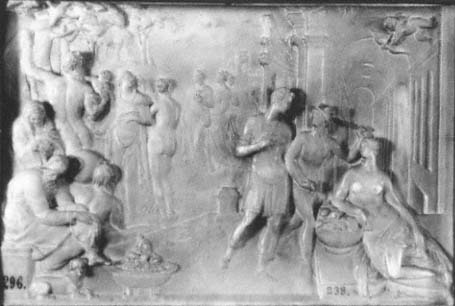
Figure 40.
Giambologna, Allegory of Prince Francesco de' Medici , c. 1560–61. Alabaster, 31 × 45 cm.
Museo del Prado, Madrid.
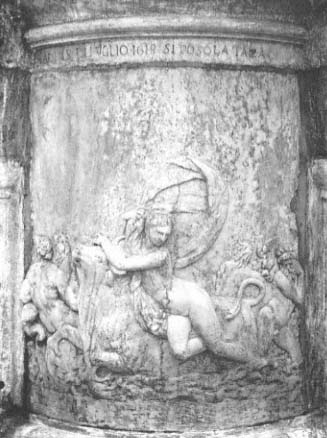
Figure 41.
Giambologna, Rape of Europa , c. 1574–75, marble.
Oceanus Fountain, Boboli Gardens, Florence.
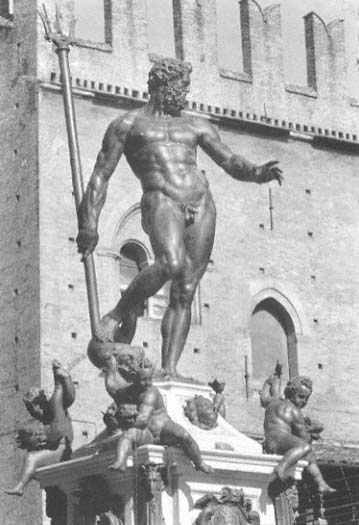
Figure 42.
Giambologna, Neptune Fountain, 1563–66. Bronze, 335 cm (Neptune figure).
Piazza del Nettuno, Bologna.
he was relatively inexperienced in relief sculpture, the Allegory of Prince Francesco de' Medici (Fig. 40) and the stone reliefs on the base of the Oceanus Fountain (Rape of Europa , Fig. 41) representing the extent of his work in that genre. In bronze, his expertise encompassed large works, such as the Neptune Fountain (Fig. 42) as well as many small statuettes in the same vein as the Studiolo Apollo (Fig. 43). The problems of narrative were even less familiar to him, and he had rarely dealt with religious subject matter, the Altar of Liberty (Fig. 24) for the cathedral in Lucca (1577–79) being the notable exception. Giambologna's only
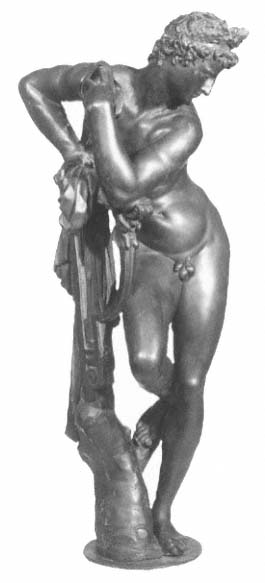
Figure 43.
Giambologna, Apollo , 1573–75. Bronze, 88.5 cm.
Palazzo Vecchio, Florence.
other religious and narrative work comparable in scale and significance to the Grimaldi Chapel was the Salviati Chapel (Figs. 20–22), just under way when the contract for the Grimaldi was signed. Both these relief cycles, with their new emphasis on narrative clarity and dramatic focus, belong to the reform age.
During the period when Giambologna was working on the Grimaldi Chapel commission, we recall that he was also finishing the famous Rape of the Sabines (unveiled in 1583; Fig. 1) and its relief. The differences, both obvious and subtle, between this work, even admitting its interpre-
tation as a political allegory of Medici rule, and the Grimaldi reliefs dramatize the revolutionary change being ushered in by the latter.[8] The two commissions share some of the same stylistic characteristics, but their goals are patently different.
In the Rape of the Sabines , solving a difficult problem of design is a principal goal. The statue is the paradigmatic embodiment of virtù, an ethical quality the sixteenth century ascribed to the arts; the demonstration of virtuosity that first engages the viewer is itself an indication of the artist's possession of virtù .[9] In the Grimaldi reliefs the story itself first compels attention. Remembering that a sixteenth-century viewer was attuned to the moral value of this demonstration, unlike the twentieth-century viewer, puts this argument in a historical, rather than a polemical, perspective. The Sabine statue, a true multiple-view work, met sixteenth-century theorists' demands that statues provide satisfying views from all sides. Spectators moving around the work experience continuously evolving views, which give the illusion of an action in progress. Even the relief (Fig. 44), with its extensive setting and pictorial form, although ostensibly a narrative, presumably intended to elaborate on the statue above, relegates the "story" to a subsidiary role, emphasizing, rather, the display of magnificent nude bodies engaged in physical struggle. One sees in this visual embellishment a parallel to the art of rhetoric in the late sixteenth century.[10] It is apparent that the impact of the relief on an audience conditioned by such theory does not lie in any story it illustrates but derives from the beauty of the design and its components: the complex intertwining of bodies, their torsion and sweeping gestures. Raffaello Borghini's story, already recounted, confirms what the eye perceives, that the aesthetic problem was the main preoccupation in both the freestanding group and the relief on the base. It is not that the statue and its relief are without subject but that the narrative content is secondary.
Two works by a single artist that are as diverse as the Rape of the Sabines and the Grimaldi reliefs owe their differences to context and function. The Rape of the Sabines is a secular work made, as far as we know, not to fulfill a commission but to appeal to the discriminating judgment of the cognoscenti. It certainly conformed to the taste of Grand Duke Francesco de' Medici, whose enthusiasm about it prompted him to have it placed prominently, next to Cellini's Perseus in the Loggia dei Lanzi, Piazza Signoria. In contrast to the Sabine statue, the Grimaldi cycle, falling in the religious sphere, had to satisfy other requirements; surely
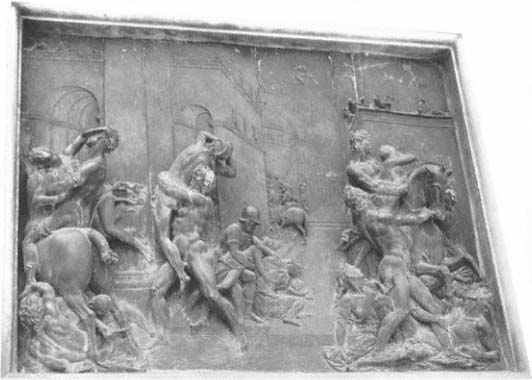
Figure 44.
Giambologna, Rape of the Sabines , 1582–83. Bronze relief, 74 × 89 cm.
Loggia dei Lanzi, Florence.
it would have been affected by the Council of Trent's general statement on art at its twenty-fifth session, in 1563, which set the stage for specific directives on the representation of sacred subjects. Local synods, led by powerful churchmen such as Gabriele Paleotti and Carlo Borromeo, then elaborated on these.[11]
Within the overall structure of his narrative Giambologna's technical means are visible principally in the composition of the reliefs: in the spatial layout and the figural and architectural groupings. But he went further than simple narrative clarity. He introduced the multiple-view technique in conjunction with multipoint perspective, thus inviting the spectator's active participation and psychological involvement in the developing narrative.
Each of the Grimaldi reliefs is similarly organized on a tripartite division of the major elements of the composition, as others have observed.
In Christ before Pilate (Plate 7), for example, there are three distinct groups of figures—Pilate's on the right, Christ's in the center, and the soldiers on the left. The architectural setting reinforces the division of the groups.
Though out of fashion in the mid-sixteenth century, this tripartite scheme had been a common compositional device in the fifteenth century and the early sixteenth. It appears as an organizing principle in theory too. Alberti's De Pictura was made up of three parts, a structure derived from the classical educational text.[12] He defined an artistically composed painting as one that represents exemplary events, expresses moral conviction, and embodies a figural allegory.[13] In the visual arts, this traditional tripartite Renaissance scheme, conspicuous in Masaccio's Tribute Money and followed in works such as Fra Angelico's Descent from the Cross (1430–34; Museo di San Marco, Florence) and Ghirlandaio's Miracle of the Spini Child (Fig. 45), was carried into the sixteenth century in Raphael's Vatican frescoes and tapestry designs, among other works. In both the Fra Angelico and Ghirlandaio the figures on either side of the central group serve as buttresses to the main event and stabilize the scene. The witnesses stand immobile as they watch the central group. A perspective view into the distance establishes the locale and gives a sense of vast space. An equally symmetrical but less severe use of the tripartite composition is apparent in Raphael's School of Athens , where architecture provides the structure but where the figures are placed in harmonious groups throughout the space instead of being relegated principally to the foreground, as in the Fra Angelico and the Ghirlandaio.
Florentine painters like Santi di Tito and Jacopo da Empoli, who were instrumental in transforming painting toward the end of the sixteenth century, turned for inspiration to Andrea del Sarto, in whose work they found the way to a revival of direct narrative, which characterized this reform in art.[14] Giambologna, too, when planning the Grimaldi reliefs, turned to painting, much as some earlier sculptors had done. Benedetto da Maiano, for example, drew freely on Ghirlandaio's designs for the Sassetti Chapel in Santa Trinità in composing his Saint Francis cycle for the pulpit in Santa Croce, Florence (Fig. 46). During Maiano's time relief often attempted to rival the pictorial qualities of painting and the distinctions between sculpture and painting, between three-dimensional and two-dimensional media, were virtually eliminated. Given his strong pictorial interest, Giambologna naturally turned to Andrea's Scalzo fres-
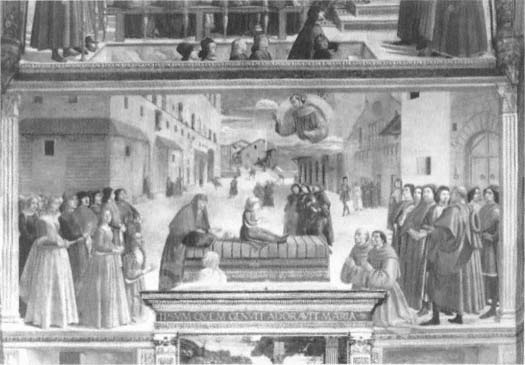
Figure 45.
Domenico Ghirlandaio, Miracle of the Spini Child , 1483–86, fresco.
Sassetti Chapel, Santa Trinità, Florence.
coes, a well-known cycle painted for the Confraternity of the Discalced Carmelites in Florence (1515–17, 1521–26).[15] Like relief, the Scalzo paintings are monochromatic; they are even composed to have a sculptural effect.[16] Furthermore, their subject, events from the life of John the Baptist, is similar enough to that of the Grimaldi cycle to have provided a rich fund of compositional ideas for Giambologna. Andrea's combination of clear exposition and suave, sophisticated figure style must also have appealed to Giambologna. A closer look at some of the individual Scalzo scenes shows how Giambologna used them as a starting point for his own designs.
Andrea's paintings, although monumental in scale, have an intimate effect in comparison with similar designs by Raphael, such as The Conversion of the Proconsul (cartoon in Victoria and Albert Museum, London). The reduced scale and simplified architecture as well as the smaller number of figures and their physical proximity made Andrea's cycle an
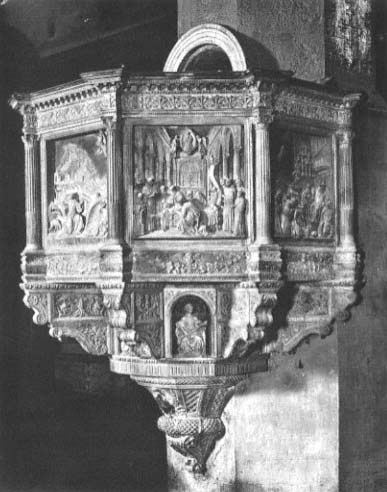
Figure 46.
Benedetto da Maiano, Pulpit, c. 1474–75, marble.
Santa Croce, Florence.
appropriate point of departure for Giambologna. Like Andrea in The Banquet of Herod (Fig. 47), Giambologna based his organizational plan on the familiar tripartite centralized scheme (Christ before Pilate , Plate 7). And like Andrea in The Decollation of the Baptist (Fig. 48), he evidently reveled in the display of muscular anatomy, tempered, however, by the smoothness evident in the figures of The Flagellation (Plate 8). Nonetheless, the differences between Giambologna's reliefs and Andrea's paintings are telling. Giambologna has modified Andrea's rigid tripartite scheme, as a comparison of The Banquet of Herod with the Grimaldi
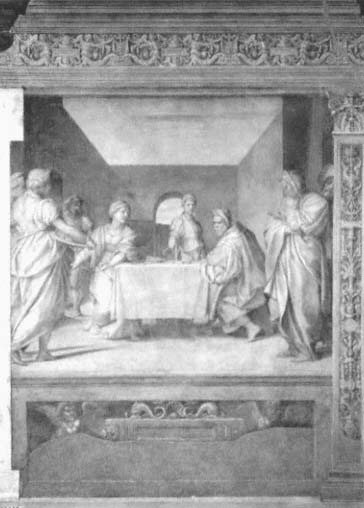
Figure 47.
Andrea del Sarto, The Banquet of Herod , 1521–26, fresco.
Chiostro dello Scalzo, Florence.
Christ before Pilate shows. Whereas Andrea's design, chiefly through its architecture, is emphatically centralized and static, Giambologna's appears slightly shifted to the left by the wall behind the main group. Austere architecture is present in both works, but Giambologna uses it to create a complex succession of spaces that recede into the background and effectively intensify the drama. The dynamic quality of The Flagellation owes much to Giambologna's use of a vanishing area around the place of action, rather than a single vanishing point in the center of
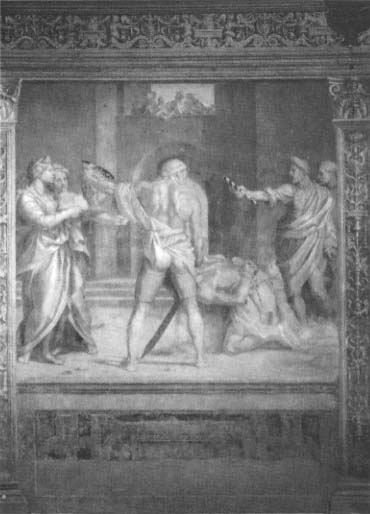
Figure 48.
Andrea del Sarto, The Decollation of the Baptist , 1521–26, fresco.
Chiostro dello Scalzo, Florence.
the scene, as in Andrea's Decollation of the Baptist . Giambologna's figures shift their weight as if in the midst of activity; Andrea's executioner is planted squarely in the center of the picture, feet firmly on the ground and weight evenly distributed. The action depicted in the relief is still in progress; that in the painting has been completed. In sum, Giambologna provides a richer and more subtle narrative.
Although he adopted the tripartite system for the Grimaldi reliefs, Giambologna varies it from relatively strict symmetry to a more asym-
metrical arrangement. In all the reliefs there are two groups close to the viewer on either side of a principal group, placed back slightly. This affords the viewer a clear passage into the scene while simultaneously defining the spatial limits of the event. Four of the reliefs, Christ before Pilate, The Flagellation, Christ Crowned with Thorns , and The Way to Calvary (Plates 7–9, Fig. 5), are symmetrical, with the central placement of the main figures emphasizing the tripartite arrangement. The central group in these four reliefs is the first to catch the viewer's eye. The side groups act as parentheses. In Ecce Homo (Plate 10) and Pilate Washing His Hands (Plate 11), which are more asymmetrical, the main groups are shifted off to one side, leaving the crowd to occupy the left half of Ecce Homo and Christ's group to occupy the right center of Pilate Washing His Hands . Significantly, these variations in the triadic grouping serve the dramatic needs of the narrative. The crowd's responsibility for condemning Christ and its participation in the condemnation in Ecce Homo are accentuated because the crowd itself is shown as a unified group clamoring for and pressing in on the defenseless victim. In Pilate Washing His Hands , the placement of Pilate's group to the left and Christ's deeper and to the right of center heightens the import of the subsidiary event.
Diagonals figure prominently in the organization of the composition and the handling of space. For example, in Christ before Pilate (Plate 7) and Pilate Washing His Hands (Plate 11) they underline the psychological significance of the deep corridors of space between Pilate and Christ. Further, they organize the figures into groups, creating relationships between individual figures in the groups that highlight the dramatic events of the story. This technique is particularly evident in Pilate Washing His Hands , where the striking impact of the diagonally positioned group leading Christ away is largely due to its placement. The physical force of the exit and the import of Pilate's decision are thus accentuated. Similarly, a strong dramatic clarity prevails in Christ before Pilate and in Ecce Homo .
Diagonals not only organize the figural groups but also relate them to one another within a scene to focus and clarify the action. Christ Crowned with Thorns (Plate 9) is a case in point. The soldier on the left, nearest the spectator, links the central group with Christ to the crowd packed under the arcade at the left. He stands obliquely to the picture plane, glancing emphatically back over his shoulder at the group in the arcade, but with his body turned to face Christ's group in the center. By connecting the groups, his figure establishes the flow of the narra-
tive. The same figure also links the relief with the spectator's space. His right arm, conspicuously bent and resting on his hip, boldly breaks the surface of the relief and emerges on a diagonal directly into our space. His legs—the outer one flexed slightly, the inner one more—are positioned to produce the illusion of movement if the viewer shifts to either right or left. The same articulation is used in the figure of the tormentor to Christ's right. A close analysis of the placement of Christ's body in space reveals a similar composition. Different parts of his body are subtly adjusted to relate to both groups of spectators within the panel and to those looking from outside the relief as well. The turn of Christ's head to the left side of the scene is powerful enough to balance the direction of his torso and legs, which are turned to the right. The inclination of his head, as well as that of other figures, and the exchange of glances between them, operate diagonally, reinforcing the illusion of depth and relating parts of the scene to one another.
Joined to the function of diagonals and crucial to the dramatic success of these scenes is Giambologna's construction of the space in relation to the figural grouping. He conceived space dynamically and has, accordingly, given it an active role, thus intensifying the viewer's perception of the human confrontations. In the reliefs of Donatello, Giambologna must have found inspiration for the manipulation of space to create dramatic tension. In Donatello's Feast of Herod relief (Fig. 49), for example, the use of space intensifies the emotional content of the episode. Although it is the severed head of the Baptist that makes all the spectators recoil, those crowded at the right seem to have been pushed back even further from the horror they see, leaving a void at the foreground that is singularly effective in conveying their revulsion.
Giambologna's continuation and development of Donatello's idea may be seen in the panel Christ before Pilate (Plate 7), where the space created by the barrel-vaulted colonnade serves both as a compositional and as a dramatic focus. The viewer's eye is arrested at this point and the mind is engaged in the dramatic confrontation between the main characters of the drama. The plunging space separates Christ and Pilate physically and psychologically, while the archway over the space connects them visually. Once this connection is established, the bridge created by the archway draws the viewer's eye into the conflict. Thus pictorial space is used to express the main actors' psychological isolation from one another, while the architectural design binds them together in the same physical environment.
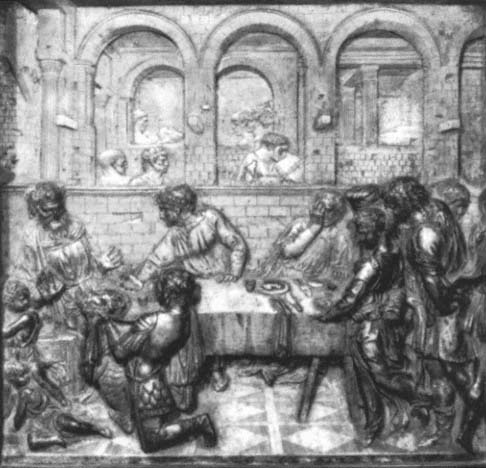
Figure 49.
Donatello, The Feast of Herod , c. 1425. Gilt bronze, 58 × 58 cm.
Baptistery, Siena.
Architectural components enhance the expressive role of space, serving as structural devices and playing against the illusionism in each relief. Deep spaces created by architectural settings in both Ecce Homo (Plate 10) and Pilate Washing His Hands (Plate 11) help produce a strong emotional effect. In Ecce Homo , a scene fraught with conflict between Pilate and the crowd, prominent steps and a long narrow street between loggia and buildings separate the two groups. The steps provide the physical bridge, whereas the space between buildings emphasizes psychological
separation. Pilate Washing His Hands , in which Pilate's wish to be absolved from the responsibility of condemning Christ is countered by the soldiers dragging Christ off, is even more poignant. The void placed conspicuously almost at the center of the composition embodies the sense of separation and ultimate tragedy of the scene.
Space, besides being an active participant in the relief scenes, works interdependently with time. As the narrative unfolds, the viewer is presented with long vistas down arcades and streets and incomplete views of buildings, as in Christ before Pilate (Plate 7) and The Flagellation (Plate 8). Perhaps Giambologna's ideas for these sweeping vistas came from his Florentine contemporaries Mirabello Cavalori and Girolamo Macchietti, with whom he had worked side by side a decade earlier in Prince Francesco de' Medici's Studiolo in the Palazzo Vecchio. Both Cavalori's Wool Factory (early 1570s) and Macchietti's Baths of Pozzuoli (Fig. 50) are remarkable for their breathtaking vistas down corridors created by architectural surroundings.[17] To return to Christ before Pilate , the partial view strongly implies the presence of what is unseen. Space becomes infinite and continuous and suggests that the scene could change at any moment; more people and more buildings might appear. The impression of transience introduced here by Giambologna's use of the fragmentary is an attempt to relate the represented event to the viewer's own experience in life. A highly pictorial treatment of the backgrounds is counterbalanced by the tangibility of the foreground groups, a technique in which figures emerge almost fully rounded to form a bridge between the illusion of three-dimensional space and the reality of the observer's space.
As I remarked earlier, one of Giambologna's major concerns in the Grimaldi reliefs was the relationship between the viewer and the event depicted, a concern that had occupied artists for more than a hundred years. Alberti had recommended that each work of art have one figure whose sole function was to make contact with the spectator and to point out the action in the picture.[18] There are numerous examples of such figures in both painting and relief from the early fifteenth century through the sixteenth. Apparently following Alberti's prescription, Fra Angelico in his San Marco altarpiece (Fig. 51) placed the saint conspicuously in the left foreground, where, by glance and gesture, he invites the viewer to focus on the Madonna and Child, seated well back in space in the center of the painting. Botticelli's 1472 Adoration of the Magi (Uffizi, Florence) also uses such a device.
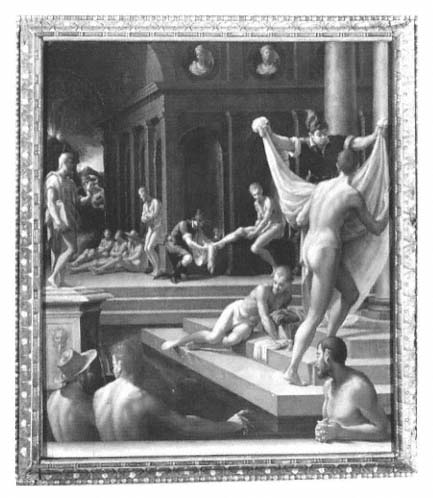
Figure 50.
Girolamo Macchietti, The Baths of Pozzuoli , 1570–72.
Studiolo of Francesco I, Palazzo Vecchio, Florence.
By the early sixteenth century, contact with the spectator in the work of the first-generation mannerists assumed a major, often exaggerated, importance. The two youths carrying the body of Christ in Pontormo's Santa Felicità Entombment (Fig. 52) almost dominate the work because of their insistent contact with the viewer, as they stare intently out of the painting. In maniera paintings such as Bronzino's Christ in Limbo (Fig. 53), it is standard to have at least one prominent figure look straight at the spectator. Diverting attention from the focus of the narrative, these conspicuous interlocutors follow the tradition of rhetorical embellishment and ornament esteemed by Florentine cognoscenti like the artist-critic Giorgio Vasari and his close friend and intellectual advisor Vincenzo Borghini.
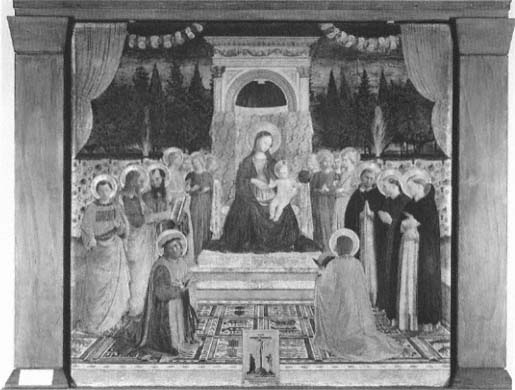
Figure 51.
Fra Angelico, Madonna and Saints , c. 1438–40. Panel, 219 × 227 cm.
Museo di San Marco, Florence.
In the Grimaldi reliefs, Giambologna changes the viewer's relationship to the work of art from a self-conscious appreciation of the aesthetic content to a direct involvement in the story. The intention is not, as in maniera works, to call attention to the contact figure by isolating it from the rest of the composition but to put the viewer in closer touch with the scene. Consequently, Giambologna places one or more sculpted spectators at the edge of the relief, often overlapping the frame and thus penetrating the viewer's space. Donatello's fifteenth-century San Lorenzo pulpits, outstanding examples of interaction between viewer and image that had been reinstalled in the nave of the church in the sixteenth century, were important precedents for Giambologna. Spectators in his works, as in Donatello's, create a tangible physical connection to the viewer's environment. With respect not only to the viewer but also to the episode illustrated, the spectators in each Grimaldi panel bridge the gap between fictive and real space and invite the viewer to
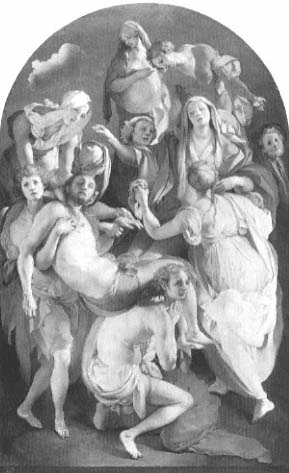
Figure 52.
Jacopo Pontormo, The Entombment , 1525–28. Panel, 312 × 193 cm.
Santa Felicità, Florence.
enter the scene. The figures in the crowd in Ecce Homo (Plate 10) are examples. They stride in at an oblique angle from both sides, that is, from the viewer's space. The open foreground of the relief makes the viewer part of the crowd. Similarly, in Pilate Washing His Hands (Plate 11), viewers can easily take their place beside the man stroking his beard at the left edge of the panel.
But Giambologna's principal way of changing the relationship between viewer and work of art was his creation of multiple views in his reliefs, as in his freestanding sculptures. A sculptural composition having multiple views, that is, having more than one or two satisfactory view-
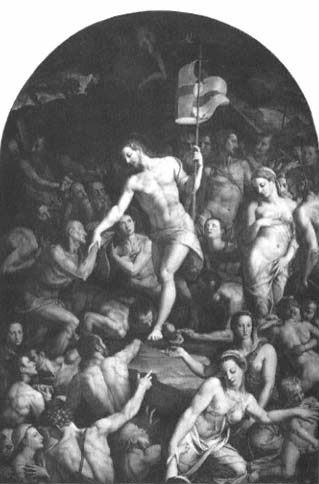
Figure 53.
Bronzino, Christ in Limbo , 1552.
Museo di Santa Croce, Florence.
ing points, enabled, indeed required, the viewer to assume more than one position. Although the spectator can take in only one view at a time, a succession of views in a work so constructed exists in the mind as an ongoing experience. Giambologna's Rape of the Sabines (Fig. 1), for example, impels the viewer to circle the work to gain its full impact. The concept of multiple views, current in Florence in the mid-sixteenth century, is most commonly associated with freestanding sculpture. Although it may seem impossible to apply it to relief, which cannot be circled, it works within the limitations determined by the planar character of the relief.
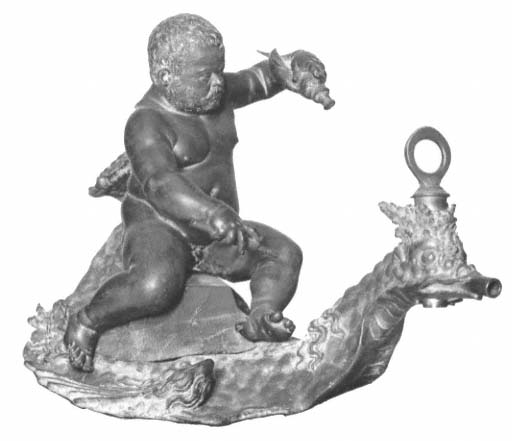
Figure 54.
Giambologna, Morgante , c. 1582. Bronze, 36.5 cm.
Museo Nazionale, Florence.
The ideal realization of the multiple view was a matter of considerable debate among theorists and artists. Although Cellini, for example, in his reply to Benedetto Varchi's Inchiesta of 1546 on the relative merits of painting vis-à-vis sculpture, wrote that a statue ought to have eight views, his opinions on this subject were not always consistent.[19] Vasari explains in his Vite that a statue should look equally satisfying from all sides. Echoing Vasari's opinion, Raffaello Borghini, in Il riposo , 1584, says that freestanding sculptures should be made so that they can be admired from all sides. Giambologna, closely associated with the group that congregated at the Villa Il Riposo to discuss this and many other aesthetic issues, must have been concerned with them himself. A sculpture less well known than the Rape of the Sabines but equally brilliant, the little bronze fountain figure Morgante (Fig. 54) illustrates how perfectly
Giambologna understood the concept of the continuous multiple view, which could be realized only in sculpture.[20] In these works the kinematic effect created by constantly evolving views produces the illusion of an action in progress, requiring the physical participation of the viewer.[21] Each position of the spectator is linked to the one before and to the one that will follow, to create a chain of temporal and spatial experience. As the spectator changes position, the work of art appears to move into a subsequent moment of the action or event. Time thus becomes an issue in the meaning of the work. The unfolding of time through the active participation of, rather than the passive viewing by, the spectator creates a dynamic interaction between viewer and work of art. Throughout his career Giambologna was occupied with the problem of multiple views in freestanding sculpture. The Grimaldi commission gave him an opportunity to develop the technique, this time in relief and with the objective of producing a viewer-oriented narrative of Christ's Passion.
Perhaps Giambologna had a further motive, conscious or not, for using multiple views in the Grimaldi reliefs: his desire to add another chapter to the paragone debate. Relief is a pictorial competitor of painting, but it is also a bridge between sculpture and painting and therefore a means of eliminating the separation and accomplishing the unification of the arts, an issue of prime significance in the late sixteenth century.[22] In his 1546 Inchiesta Varchi had elicited the opinions of famous artists such as Michelangelo, Cellini, and Bronzino on the relative merits of painting and sculpture. Cellini's claims concerning multiple views put sculpture ahead. In about 1553, however, Bronzino, in his double-sided painting of Morgante (according to an article by Holderbaum), successfully refuted Cellini's claims for sculpture.[23] In the 1580s Giambologna took up Bronzino's challenge in the bronze Morgante , ostensibly reestablishing the supremacy of sculpture. Extending this innovation into the medium of relief was Giambologna's extraordinary accomplishment.
The implications of combining the multiple-view technique and multipoint perspective in narrative relief are worth considering. Such works of art have no single ideal viewing point, or even fixed alternative viewing points, but can be seen from different angles, from which their subjects read differently. Furthermore, different views evoke different responses. Any of the Grimaldi reliefs may be seen satisfactorily from many positions, but at each they take on a different shade of meaning. Multipoint perspective is a necessary corollary of multiple views. Ac-
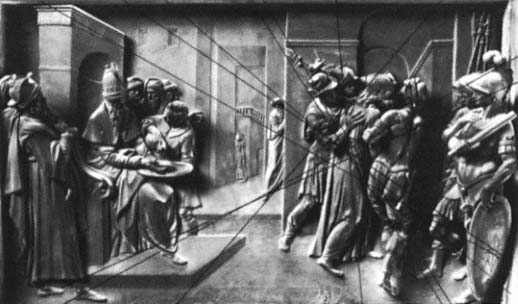
Figure 55.
Giambologna, Pilate Washing His Hands , c. 1585–87. Bronze, 47 × 71 cm, with overlay.
cording to this system, a fixed or single vanishing point is replaced by a vanishing area in which orthogonals converge (Fig. 55). As a consequence, the action portrayed appears to unfold, and the viewer is freed from the fixed viewing point.
If we take as a demonstration three views from different vantage points of Pilate Washing His Hands (Figs. 56a–c), we can see how this phenomenon works. These three, among the many views possible, show an unfolding narrative. The multiple-view technique that creates this narrative also permits relief to function like freestanding sculpture.[24] A viewer standing at the left side of the relief close to the relief figure near that edge (Fig. 56a) sees the scene from that figure's vantage point. Christ's frail body on the far side of the relief nearly disappears under the rough handling of the two soldiers who push and drag him away. Twisting sharply and tensing their muscular bodies, the soldiers stride off with their prisoner in a compact group, which is set on a striking orthogonal. The viewer looking at the back of Christ's head as he is being pulled away clearly sees three soldiers lined up at the right edge
of the relief. The most prominent of the three overlaps the frame; the turning of his body propels the viewer's eye toward the center of the relief. Here, the corridor of space between the buildings seems traversable even as it distinctly separates the activities of the two main actors in the story. From this vantage point the face of a significant actor in the drama, the young black boy who pours the water for Pilate's hand washing, is riveting.
From a position directly in front of the relief (Fig. 56b), the overtones of the event change subtly. The irregular triangular space in the center foreground emphatically separates Pilate's group from Christ's, making the action instantly comprehensible. Viewers have a clear, if somewhat detached, view of the scene, comparable to that of an audience watching a play. From this vantage point the acute orthogonal created by the bodies and legs of the soldiers shoving Christ away propels the eye directly from the lower right corner of the relief to Pilate's group on the other side. His group, in turn, arranged on a less acute orthogonal, directs the eye down the street into deep space. The clear and judicious placement of the figures in their architectural setting thus both separates and relates these two groups.
Still a third viewing point, from the right of center (Fig. 56c), produces another impression of the event, one that involves the viewer more intensely in the drama, partly because the group with Christ is now physically closer. This intense involvement begins with the view of the bulging muscular back of the soldier grasping Christ. His physical effort, evident in all of his flexed muscles, is matched by the intentness of his gaze into Christ's face. Just as engrossed, the soldier on the other side of Christ stares at the back of Christ's head, pushing vigorously from behind. The dramatic effect of these two powerfully activated figures is strengthened by their proximity to the fragile figure of Christ, who makes no effort to resist. The simultaneous view of Pilate, who concentrates on his hand washing while the young black servant stares into his face, heightens the import of the hand-washing ritual. The figure at the left edge of the relief who overlaps the frame, into whose face we look, leads back again to Christ's group.
The result of assuming a succession of vantage points in front of Pilate Washing His Hands would be variations of the three impressions of the scene just described. Although any view of the relief presents an understandable image, a shifting physical relationship yields subtle changes of meaning.[25] Accordingly, the story is not limited to one interpretation.
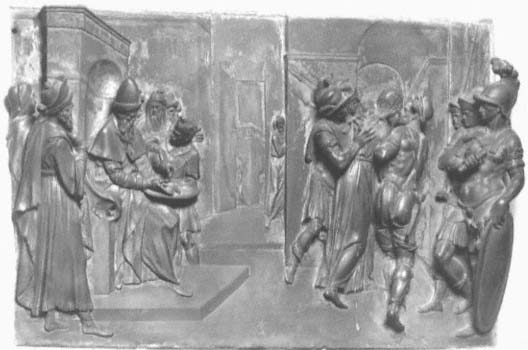
Figure 56a.
Giambologna, Pilate Washing His Hands , from the left.
Università, Genoa.
Shifting views can, for example, focus on Pilate's effort to absolve himself of the responsibility for Christ's condemnation or on the plight of Christ in the hands of the soldiers. The multiple views expose the richness and complexity of a story, laden with psychological and moral questions, that might otherwise have been limited in time and space.
The other Grimaldi reliefs similarly exemplify the effect of varying points of view on a viewer's interpretation of the subject. A frontal view of Ecce Homo (Fig. 57a) suggests to the viewer the noisy clamor of the gesticulating crowds on either side of Christ. From the left (Fig. 57b), however, the fragile bent figure of Christ above the throng gains the viewer's undivided attention. A similar effect prevails in The Way to Calvary (Figs. 58a–c), despite its flatter surface. The dramatic meeting of Christ and Veronica commands the attention of the viewer who stands just to the right of center of the relief (Fig. 58b). Moving close to Veronica's own position, farther to the right, the viewer is able to experience her more personal involvement as she looks into the face of Christ
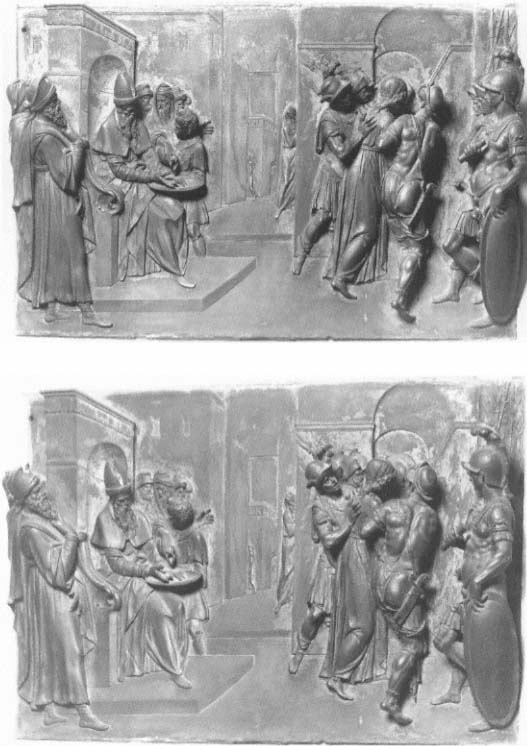
Figure 56b (top of page).
Giambologna, Pilate Washing His Hands , frontal view.
Università, Genoa.
Figure 56c (above) .
Giambologna, Pilate Washing His Hands , from the right.
Università, Genoa.
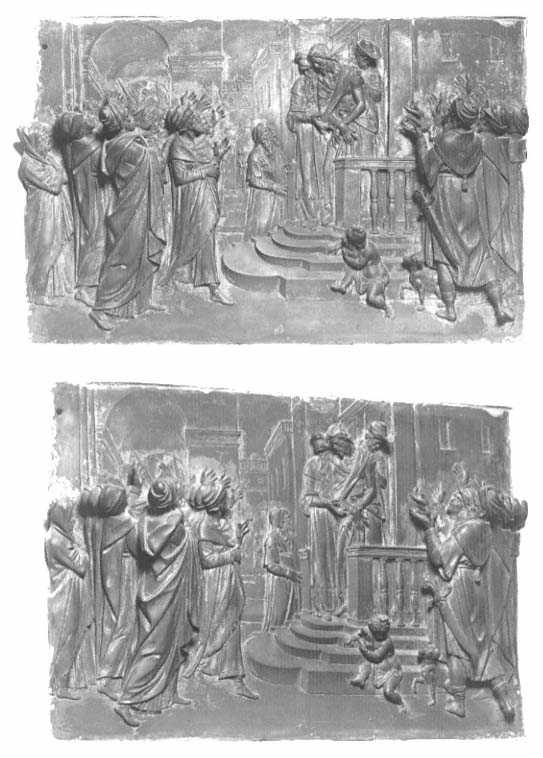
Figure 57a (top of page).
Giambologna, Ecce Homo , c. 1585–87. Bronze, 43 × 71 cm, frontal view.
Università, Genoa.
Figure 57b (above) .
Giambologna, Ecce Homo , from the left.
Università, Genoa.
(Fig. 58c). The advancing row of horses and soldiers at the left conveys the inevitability of this death march.
Thus Giambologna's narrative reliefs, by presenting the spectator with many possible views, effectively attack what might be called the tyranny of the single point of view and give the spectator a freedom of choice and an opportunity to become deeply involved in the nuances of the story, an altogether more subjective approach to visual representation than had occurred previously. A consideration now of some earlier masterpieces of pictorial relief can help us judge Giambologna's place in the history of the genre. He was both eclectic and synthetic in his achievement.
Many works of two great revivers of pictorial relief in the early Renaissance, Ghiberti and Donatello, whose Feast of Herod (Fig. 49) has been discussed, were visible daily to Giambologna in Florence from his arrival in 1556.[26] Reminiscences of Ghiberti's flowing rhythms and lyricism are found in some passages of the Grimaldi reliefs, especially in the figure of Christ in The Flagellation (Plate 8), strikingly similar in form and effect to the Christ of Ghiberti's Flagellation (Fig. 59) on the north doors of the Florentine Baptistery. The grace and beauty of both are reminiscent of the late classical style of Praxiteles, as seen in the Apollo Sauroctonus.[27] The ancient work's celebration of soft sensuous male beauty becomes in the Christian context of the Flagellation a reflection of the beauty of the divine.
The opportunity to study Ghiberti's relief cycle of Christ's life on the north doors of the Baptistery as well as his magnificent cycle of Old Testament scenes on the Gates of Paradise must have had its effect on Giambologna. Taking his cue from Ghiberti in creating a supportive but unobtrusive setting, Giambologna established a proportional relationship between figures and architecture similar to that in the north doors, as a comparison of Giambologna's Pilate Washing His Hands (Plate 11, Fig. 56b) with Ghiberti's (Fig. 60) shows. Giambologna's relief seems a further development and elaboration of the basic idea formulated by Ghiberti over a hundred years earlier, in which the figures dominate but the architecture provides the essential locus and helps accent the principal figures. Ghiberti's relief, however, has only the barest hint of spatial illusionism in the background, which crowds in on figures that almost completely fill the foreground. In the Ghiberti panel, unlike the Grimaldi, nearly all the space derives from that created by the figures themselves. Rather than crowding his figures on the foreground plane as Ghiberti did, Giambologna has distributed them in a gradually receding
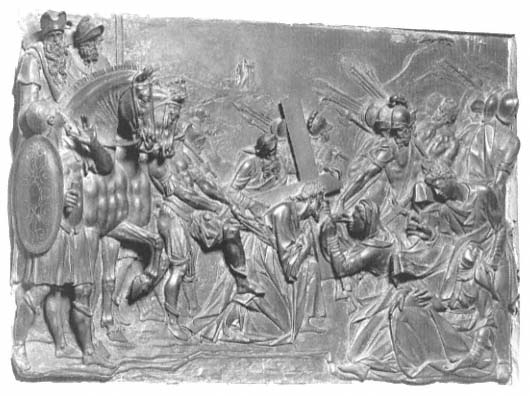
Figure 58a.
Giambologna, The Way to Calvary , c. 1585–87. Bronze, 47 × 73 cm, from the left.
Università, Genoa.
space, which derives its limitless appearance partly from the architecture of the setting. Furthermore, Ghiberti seems not to have taken the spectator's position into consideration, as Giambologna so clearly has.
Some of the feeling of spatial illusionism and amplitude in Ghiberti's Jacob and Esau (Fig. 61) has been adapted by Giambologna, whose rectangular format, however, lends itself to a tighter structure in which the figures are relatively more important; Ghiberti's nearly square format results in an airy composition that exudes a sense of tranquillity and harmony despite the intensity of the event. Giambologna's narrative, in contrast, is laden with dramatic tension.
More significant, however, is the difference between Ghiberti's simultaneous narration, in which several episodes of a story are represented in the same picture frame, as it were, and Giambologna's multiple views.[28] In simultaneous narration observers seem to have the freedom to "read" the image as they will, but in fact, if the story is to be understood, there is only one way to read it, in the correct temporal sequence.
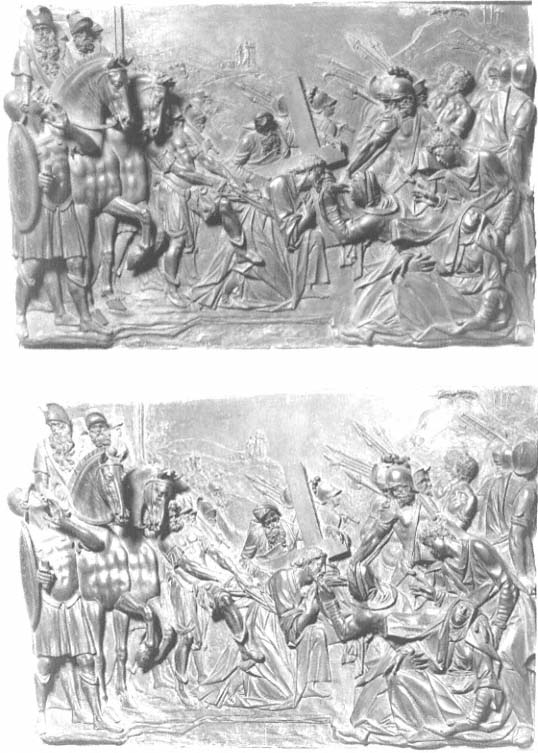
Figure 58b (top of page).
Giambologna, The Way to Calvary , frontal view.
Università, Genoa.
Figure 58c (above) .
Giambologna, The Way to Calvary , from the right.
Università, Genoa.
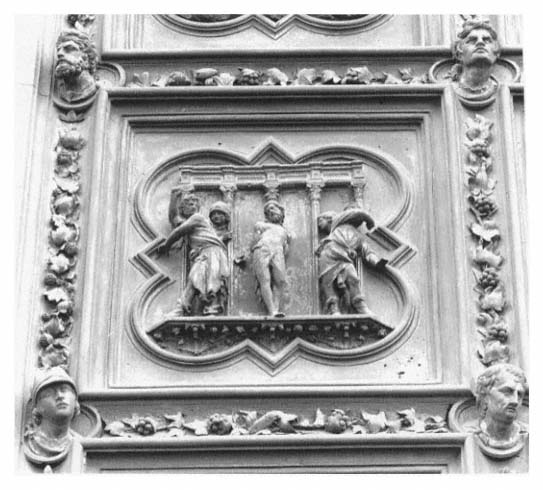
Figure 59.
Lorenzo Ghiberti, The Flagellation , c. 1416–19. Gilt bronze, 46 × 40 cm.
North doors, Baptistery, Florence.
In contrast, Giambologna's multiple views of a single episode give the viewer the opportunity to experience shades of meaning in an unfolding narrative.
But the multiple-view device operates only when accompanied by infinite, or continuous, gradations of relief, as in the Grimaldi cycle. Ghiberti's Pilate Washing His Hands (Fig. 60) admirably demonstrates the difference between continuous and noncontinuous gradations. Each layer or level of Ghiberti's figures projects a uniform distance from the plane, to which the figures themselves are parallel or oblique. They are not, in other words, composed, like Giambologna's, in spirals that give the effect of continuous gradations of relief. His technique not only
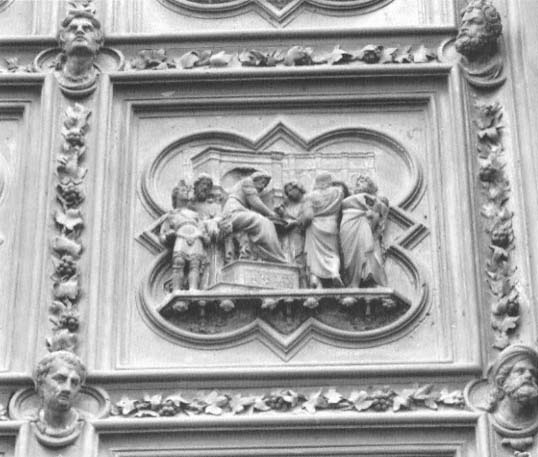
Figure 60.
Lorenzo Ghiberti, Pilate Washing His Hands , c. 1416–19. Gilt bronze, 46 × 40 cm.
North doors, Baptistery, Florence.
gives convincing three-dimensionality to the figures but also suggests movement in and out of a space that is not divided into either compartments or successive parallel planes. Many single figures demonstrate continuous gradation from high relief to schiacciato . One such notable figure is Simon of Cyrene, who helps Christ carry his cross (Fig. 62) in The Way to Calvary . The head, modeled in high relief, projects toward the spectator, casting a prominent shadow, while the left arm flattens out behind an arm of the cross, only to reemerge as Simon's hand grasps the top of the cross near Christ's head. Similarly, the head of Christ in Ecce Homo (Fig. 63) is actually detached from the ground; his bare arm is modeled in the round, while much of his body seems to recede into
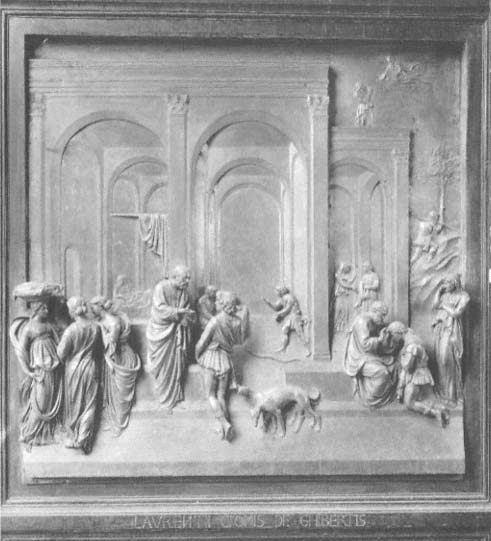
Figure 61.
Lorenzo Ghiberti, Jacob and Esau , c. 1435. Gilt bronze, 70.8 × 70.8 cm.
Gates of Paradise, Baptistery, Florence.
the matrix of the panel. Equally impressive is the handling of the man standing in the center foreground of the crowd (at the left in Fig. 63). His far side and midsection cling to the panel, while his head, shoulder, cape, and right leg (see Plate 10) bend out toward the viewer. Infinite gradations, such as those found in single figures like these, play a prominent role in the overall effect of each relief in the cycle. Again in The Way to Calvary (Figs. 58a–c), although it is the relief with the least pro-
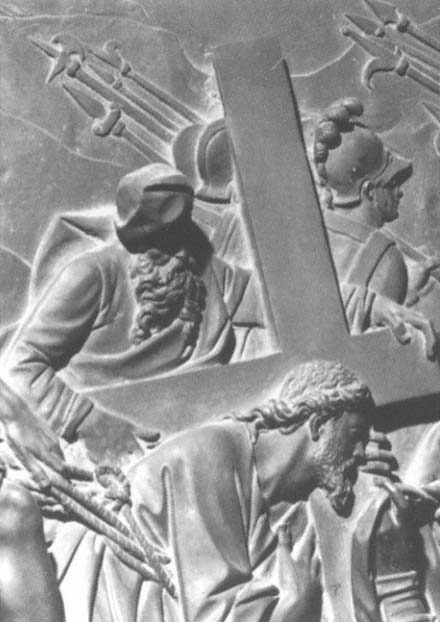
Figure 62.
Giambologna, Simon of Cyrene, detail from The Way to Calvary , c. 1585–87, bronze.
Soccorso Chapel, Santissima Annunziata, Florence.
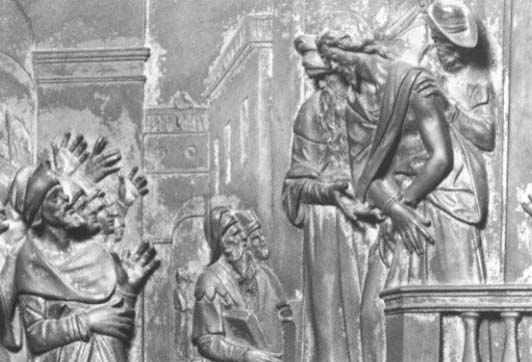
Figure 63.
Giambologna, Ecce Homo ,c. 1585–87, detail, bronze.
Università, Genoa.
jection, continuous gradation from high to low is clearly visible. Between the projecting body of the soldier at the far left, who stands in the viewer's space, and the shoulder of the soldier to the right of the horses, the projection of the figures continuously diminishes so that the figures in the distant landscape appear as little more than "graffiti."
When devising ways to enliven the Passion scenes, Giambologna undoubtedly recalled Roman art, which makes extensive use of continuous gradations in relief. As a young sculptor he had spent two years, 1554–56, in Rome.[29] The accounts of his Roman sojourn, however meager, all attest to his admiration for Roman sculpture, recording that he made many models of famous works in wax and clay, which he brought with him to Florence in 1556.[30] Roman reliefs existed in abundance for him to see. On this first visit, as well as on subsequent trips to Rome, Giambologna would have been fortunate enough to see such monuments as the passageway reliefs on the Arch of Titus, still free of the disastrous effects of air pollution. The Roman genius for creating the excitement and immediacy of an event, particularly in art of the
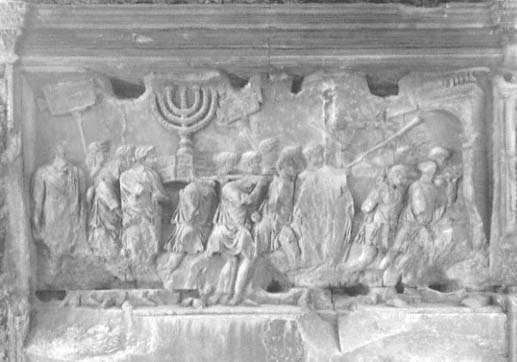
Figure 64.
Procession of Spoils of Jerusalem , A.D. 81, marble.
Arch of Titus, Rome.
Flavian period, must have sparked Giambologna's interest.[31] The Procession of Spoils of Jerusalem (Fig. 64) from the Arch of Titus exhibits a spatial illusionism, similar to that of the Grimaldi reliefs, created by figures that emerge gradually from the subtlest low relief in the background to higher and finally almost fully rounded forms in the foreground. Such is the sense of immediacy that the action seems to take place before our eyes. Other elements of these reliefs also resemble elements of Giambologna's—relationships between figures and setting, for example, in which figures dominate while the setting provides support for the evolving drama. Ostensibly realistic details detectable in the Grimaldi panels, such as the accurately rendered dress of the Roman soldiers and the handling of the soldiers' spears, evoke the flavor of the early first-century Roman world and place Christ's Passion in its historical setting. Relief in the Grimaldi cycle varies from a maximum projection of 10 centimeters to a minimum of barely 1 centimeter, so that the figures emerge and recede in a spatial arena that mimics the space of the spectator. Concomitantly, figures twist and turn through spatial planes, creat-
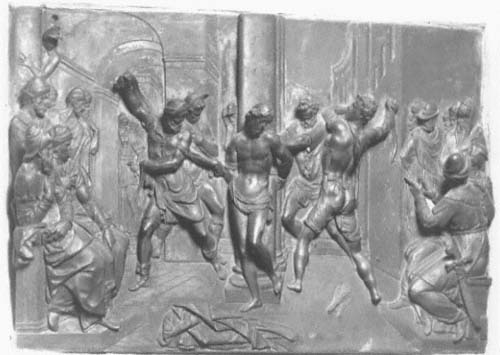
Figure 65a.
Giambologna, The Flagellation , c. 1585–87. Bronze, 47 × 73 cm, from the left,
Università, Genoa.
ing the illusion of a spiraling motion that leads the eye continuously around the panel as if an extended contrapposto infused the whole composition.[32]
How well this device works with that of multiple views may be seen in the familiar example of Pilate Washing His Hands (Plate 11, Figs. 56a–c). The body of the muscular soldier dragging Christ away is a spiral that culminates in his head, leading the eye around behind the figure of Christ to the other soldier pushing Christ from behind. The action of this group is thus completed. Simultaneously, the tilted head and bent arm of this second soldier carry the eye to the other side of the scene where Pilate is washing his hands. In Pilate's group the sharp torsion of the black boy's body unites the group behind him and focuses the viewer's attention on Pilate, whose chest and shoulders turn toward the viewer while the lower part of his body extends toward Christ and the soldiers.
The most active of the reliefs, The Flagellation (Figs. 65a–c), demonstrates how the twisting and turning of figures through spatial planes
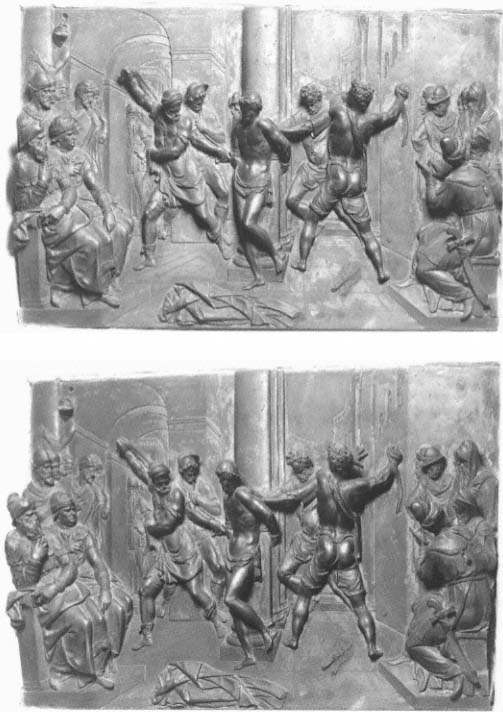
Figure 65b (top of page).
Giambologna, The Flagellation , frontal view.
Università, Genoa.
Figure 65c (above).
Giambologna, The Flagellation , from the right.
Università, Genoa.
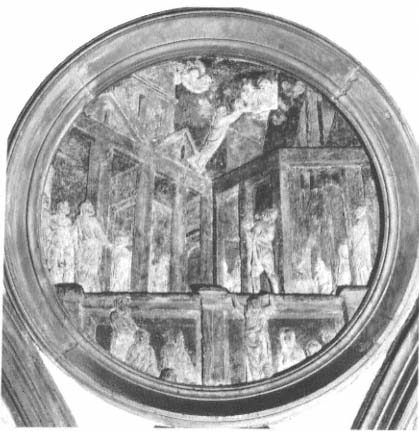
Figure 66.
Donatello, Assumption of Saint John , 1437–43. Stucco, 215 cm diam.
Old Sacristy, San Lorenzo, Florence.
create a strong effect of centrifugal movement around the body of Christ and help integrate the side groups into the action. These groups respond reciprocally to the actions of the flagellators. Whereas the seated spectators in the right corner turn predominantly in, echoing the flagellator whose back is turned to the viewer and balancing the flagellator facing front, those at the left turn out toward the viewer but look in. Giambologna has composed the figure of Christ to incorporate all these directions, so that, here as elsewhere, it unfolds in a slow spiral, turning continuously in space to relate to surrounding figures as well as to the many possible positions of the viewer. The spiral of the body, the three-dimensionality of the figure, and the opposing directions of the head and chest relate the side groups to the center. Because parts of
Christ's body turn in contrapposto, it appears to extend laterally, but this impression is counterbalanced and complemented by the way it has been modeled in gradations of relief to create undulation in depth.
Shifting or multiple viewing points required an approach to perspective different from that of the single vanishing point canonical in the fifteenth and the early sixteenth century. As already explained, Giambologna's solution to this problem was to create a vanishing area in which a number of orthogonals cluster rather than converge on a single point.[33] Undoubtedly, Donatello's reliefs introduced Giambologna to the drastic manipulation of perspective such as that in the Old Sacristy Assumption of Saint John (Fig. 66), where the saint seems squeezed toward his heavenly goal by the sudden convergence of the orthogonals marked by the buildings below. An even more daring manipulation takes place in San Lorenzo with The Three Marys at the Tomb (Fig. 67). Here the vanishing point lies outside the relief, in the spectator's space, at the place where the Risen Christ is imagined to be. Carrying Donatello's innovations further in his creation of a vanishing area, Giambologna induces a sense of continuous movement and introduces temporality into the narrative. It works in the following ways.
In Christ before Pilate (Plate 7) the vanishing area lies around the elbow of the soldier holding Christ; it lies in the crowd on the left in Ecce Homo (Plate 10, Figs. 57a–b). Consequently, the viewer's eye lights first on the most active part of the composition, whence it is directed toward the narrative center. Other reliefs of the cycle have been handled in a similar way. Directing attention to the dramatic climax of the story, the vanishing area in Pilate Washing His Hands (Fig. 55) lies in the group leading Christ away, the result of the decision implicit in Pilate's action. The effect of the convergence of orthogonals around the flexed knee of the flagellator pushing against Christ from behind in The Flagellation (Plate 8, Figs. 65a–c) is to attract attention to the vigorous circular movement set off by the legs of all the flagellators. The effect of vanishing areas, as opposed to fixed vanishing points, is enhanced by their location off center and away from the principal actors in the story. As a result of these stylistic devices the narration becomes virtually dynamic; the viewer's eye moves continuously around the scene.
Giambologna's approach to narrative, as defined here by the Grimaldi reliefs, constitutes a striking departure from that chosen by practitioners of the maniera , and even from his own early Allegory of Prince Francesco de' Medici (Fig. 40). Three examples, one each by Benvenuto Cellini
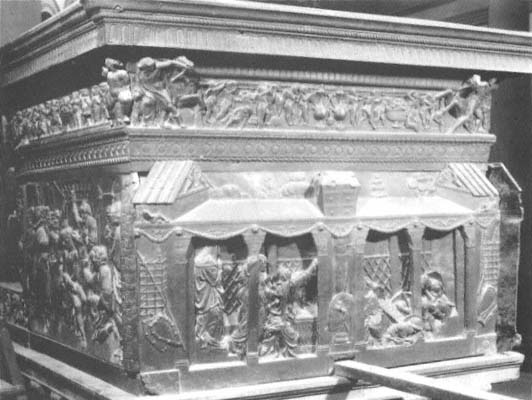
Figure 67.
Donatello, The Three Marys at the Tomb , 1460–70. Bronze, 123 × 292 cm.
South pulpit, San Lorenzo, Florence.
(1500–1571), Pierino da Vinci (d. 1554), and Vincenzo Danti (1530–1576) highlight the distinction.[34]
The relief by Cellini (Fig. 68) beneath his Perseus statue in the Loggia dei Lanzi, Florence, illustrates the myth of Perseus freeing Andromeda.[35] Commissioned by Duke Cosimo in consultation with Cellini, the statue with its relief was intended from the beginning for the Piazza Signoria, a civic monument with dynastic and historical references. The representation of the myth is the paradigm of a maniera relief, in which the artist, through ornamental effects and superb craftsmanship, has turned a romantic tale of rescue into an object of aesthetic significance. Cellini uses the synoptic mode of representation, in which several episodes of the story are combined in the same frame in no apparent order but with an effect that is visually exciting. Relationships between figures, such as Perseus and Andromeda, and spatial intervals are not clear; rational time
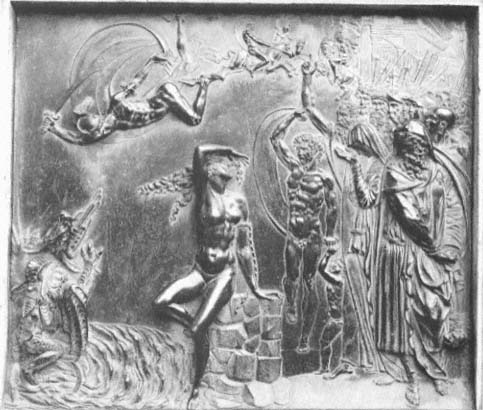
Figure 68.
Benvenuto Cellini, Perseus Freeing Andromeda , c. 1554. Bronze, 82 × 90 cm.
Museo Nazionale, Florence.
sequences have been suspended. Andromeda, awaiting her rescue, turns to view a figure that is not in her field of vision, while Perseus hurtles through a sky devoid of space and air. Andromeda, precariously balanced on a mass of rocks in the center of the scene, has been turned into an object of art whose sleek lines and glistening surfaces arrest and seduce the eye. Her provocative posture and alluring figure obliterate any interest the viewer might have in the incidents of the story; she could just as easily be an inanimate object and create nearly the same effect. Clear storytelling has been sacrificed to linear patterns and finely wrought surfaces designed to tantalize the viewer. The whole intent behind Cellini's relief contrasts sharply with that of Giambologna's Grimaldi reliefs, which place the design in the service of the narrative.
Inspired by a trip to Rome in 1549, Pierino da Vinci produced a marble relief in a consciously antique mode.[36] Entitled Cosimo I as Patron
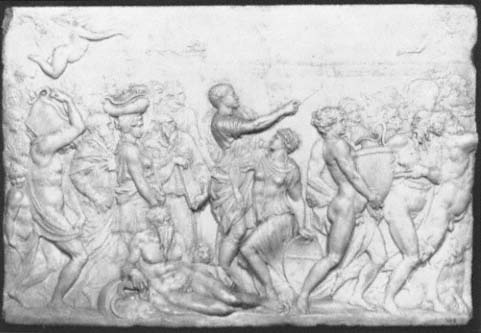
Figure 69.
Pierino da Vinci, Cosimo I as Patron of Pisa , c. 1550, marble.
Museo Vaticano, Rome.
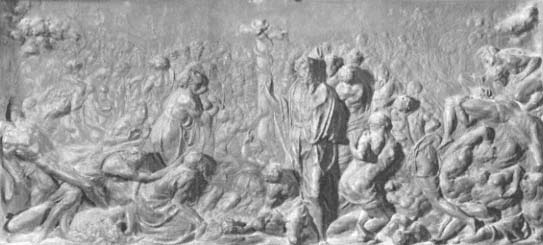
Figure 70.
Vincenzo Danti, Moses and the Brazen Serpent , 1559, bronze.
Museo Nazionale, Florence.
of Pisa (Fig. 69), the relief is an allegorical tribute to Cosimo, clothed in a narrative virtually devoid of setting; the emblematic message is carried by the figures. Pierino displays classically inspired male and female figures as they disport themselves in a procession reminiscent of those on antique sarcophagi. The postures of the figures are designed to show their heroic physiques to best advantage. Particularly conspicuous in this respect are the figures of Pisa supported by Cosimo in the center, the river god at Cosimo's feet, and the nude youth carrying the vase. Although the relief might be considered an appropriate accolade to Cosimo as ruler of Pisa, whatever historical narrative Pierino represented has been transformed by the visual rhetoric.
The religious context of Vincenzo Danti's bronze relief Moses and the Brazen Serpent (Fig. 70), unlike Cellini's and Pierino da Vinci's reliefs, is similar to that of the Grimaldi.[37] Commissioned by Cosimo, Moses and the Brazen Serpent , an analogue for the Crucifixion, was probably intended as the central section of an altar antependium, to be flanked by the Flagellation and the Resurrection and placed in the Chapel of Leo X in the Palazzo Vecchio. As distinct from Giambologna, Danti eschews a clear exposition of the story; instead he creates febrile excitement as light flickers erratically over the surface of the relief, picking out patterns that define neither anatomy nor space. The work is full of intense emotion and confusion as twisting bodies tortuously intertwine, project, and then, just as suddenly, recede into the matrix of the panel. In Danti's relief, drama and emotion result from the artist's extraordinary manipulation of the medium, in contrast to the Grimaldi reliefs, where the narrative itself elicits the emotion. Danti, an exact contemporary of Giambologna's, still operates in the maniera style of the mid-sixteenth century.
As we have seen, the maniera method gave Giambologna no solutions to his narrative task. The rich sources of inspiration for compositional structure that he found in Florence and Rome were supplemented by the brilliant religious narrative solutions he found in northern prints.[38] Since the early sixteenth century, numerous prints by northern artists had circulated freely throughout Europe. Among these were Passion cycles by Martin Schongauer, Dürer, and Lucas van Leyden. In addition to providing examples of monochromatic compositions with plastic and spatial effects much like those of relief sculpture, such print cycles approximate the fictional discourse of literature in their comprehensive relation of the story. Unlike many painted or sculpted cycles, they are
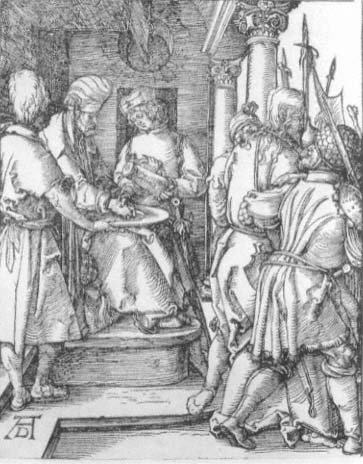
Figure 71.
Albrecht Dürer, Pilate Washing His Hands , Small Passion, 1509–11,
woodcut, B. 36.
not episodic but temporally continuous, like the Grimaldi cycle. Dürer's two versions of Pilate Washing His Hands (Figs. 71, 72), one from the Small Passion of 1509–11 and the other from the Engraved Passion, illustrate what ideas Giambologna chose to adapt from him. The latter combines Pilate's hand-washing ritual with its immediate consequence, the leading away of Christ, both shown in close-up. Two factors link the two groups: their proximity and the placement of Christ's group on a diagonal that leads the eye to Pilate. Giambologna has gone beyond either of Dürer's versions in his development of psychological interaction. To achieve this he has taken Dürer's striding group and moved it to the right and into deeper space, thus creating two foci, which are
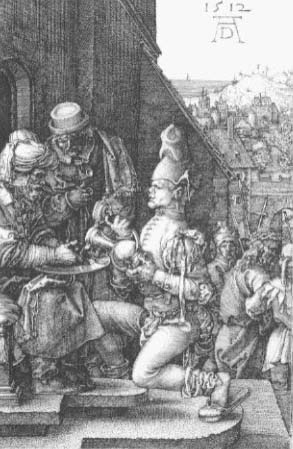
Figure 72.
Albrecht Dürer, Pilate Washing His Hands, Engraved Passion,
engraving, B. 11.
combined with a strategic use of space. A print such as Lucas van Leyden's Christ before Annas (Fig. 73), from the Round Passion of 1509, could have suggested to Giambologna the deep corridors of space he used so effectively in, for example, Christ before Pilate (Plate 7).
When Giambologna went to Genoa in July 1579 to confer with Luca Grimaldi about the chapel commission and to sign the contract, he was surely shown the magnificent Corpus Domini casket (Fig. 39), a treasure of the Cathedral of San Lorenzo, several of whose scenes in silver relief were designed by Luca Cambiaso.[39] Cambiaso was linked to Giambologna's patron as witness to the chapel contract and as creator of the Last Supper commissioned by Luca Grimaldi's father for San Francesco
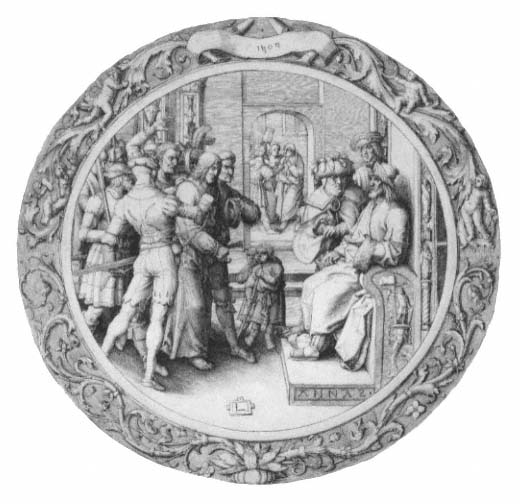
Figure 73.
Lucas van Leyden, Christ before Annas , 1509, engraving, B. 59.
di Castelletto.[40] What would have been more logical than for Grimaldi to have consulted Cambiaso, Genoa's "first" artist, when making plans for his chapel in the same church? Despite Cambiaso's responsibility for several of the Corpus Domini casket designs, the final execution by Flemish artists working in Genoa bears no relation to the style of either Cambiaso or Giambologna. Nevertheless the compositions of several of these Passion scenes, especially The Flagellation (Fig. 74), Christ before Pilate (Fig. 39), and Ecce Homo , are notably similar to those of the Grimaldi Chapel. Circumstances and certain similarities, then, argue for
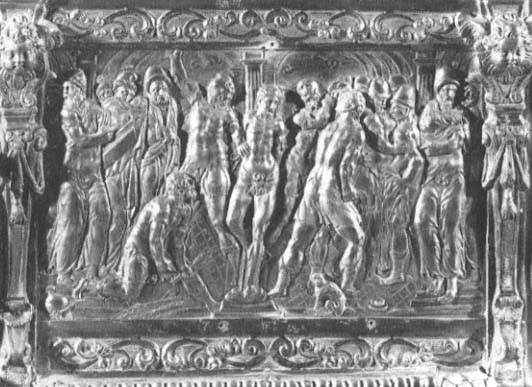
Figure 74.
Corpus Domini silver casket, 1565–68, detail, The Flagellation .
Treasury, San Lorenzo, Genoa.
Luca Cambiaso as a major influence in the designs for the Grimaldi Chapel reliefs.
Cambiaso's concern with the Passion of Christ in many of his surviving drawings and paintings, particularly of the 1570s, suggests that he and his patrons were responding to the ideas of the Catholic Reformation promoted at Trent.[41] Grimaldi, in planning his chapel program, would have found in Cambiaso a like-minded and expert consultant. Cambiaso's involvement in the subject of the Passion led him to leave Italy for Spain in 1583 to work for Philip II at the Escorial. Unfortunately, none of Cambiaso's extant drawings depicting Passion scenes can be matched to the document recording his responsibility for several of the Corpus Domini casket designs. However, Uffizi no. 13744 (Fig. 75), one of his drawings depicting the Flagellation, is a good candidate, with its similarities to the córresponding relief both on the Corpus Domini
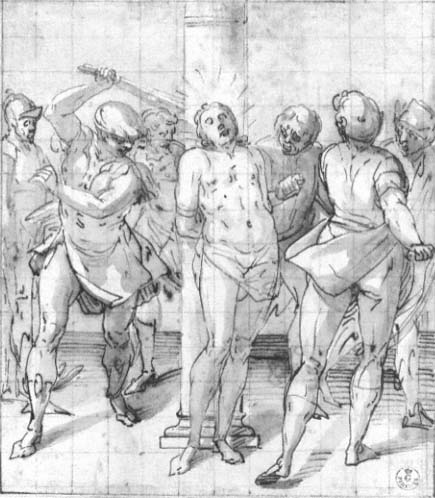
Figure 75.
Luca Cambiaso, The Flagellation , drawing no. 13744, Gabinetto Disegni e Stampi degli
Uffizi, Florence.
casket and in the Grimaldi cycle. The positioning and the posture of the two principal flagellators are essentially the same in all three versions. But the Flemish executor of the Corpus Domini relief has radically changed the proportions of the figures, made the bodies appear lumpy and inorganic, and virtually eliminated the spatial effects of the Cambiaso, so that the marvelous portrayal of action is totally lost. Giambologna, in contrast, has completely understood Cambiaso's design, translating it into relief with his own modifications.[42] Both artists aimed to catch violent physical action in progress: the flagellators are about to
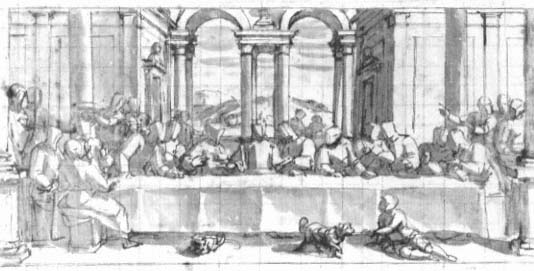
Figure 76.
Luca Cambiaso, Last Supper , c. 1579, drawing no. 1749, Gabinetto Disegni e Stampi degli Uffizi, Florence.
strike another blow. Both artists use Christ and the column as the fulcrum around which the flagellators revolve, but Cambiaso's figures seem freer to plunge in and out of space than those of Giambologna, which move laterally. The heroically proportioned bodies in both works function powerfully; and in both, spatial intervals provide ample room for the action of the figures. In addition, Giambologna must have understood Cambiaso's well-known affinity for scenographic effects, for he used them to poignant end in the spatial flights of his relief backgrounds. Cambiaso's Last Supper of 1579 in the refectory of San Francesco di Castelletto, perhaps reflected in the drawing Uffizi no. 1749 (Fig. 76), undoubtedly displayed such features.
The Entombment (Plate 12), the relief Soprani recorded as being in the Grimaldi Chapel in 1684, calls for special attention. It does not appear in the 1579 contract for the chapel, nor have any documents emerged to prove that it is a work by Giambologna. Nevertheless, there are reasons to believe he was responsible for it; certainly it seems well within his stylistic range.[43] The potentially unsettling observation that The Entombment differs too much from the other six Grimaldi reliefs may be resolved by recognizing, first, that the subject is devotional, not narrative like the six other reliefs, and that it thus requires a different treat-
ment. Its function as the altar antependium accentuates this distinction. Giambologna's ability to add a psychological dimension to the work is comparable here to what he achieved in the other six reliefs, and certain stylistic similarities exist. He retains a variation of the tripartite system, only, as in The Way to Calvary (Fig. 5), the figures are placed close to the viewer, grouped around the dead body of Christ in the center foreground. The gaping void of the sarcophagus next to Christ dramatizes the cruel fact of his death. Its purpose here is comparable to that of the deep spatial corridors that communicate psychological meaning in the other Grimaldi panels. It eloquently separates the dead Christ from Mary Magdalen, the Virgin, and John, those who were closest to him in life. The archway of the tomb on the right and the view of Calvary and Jerusalem in the background complement the grouping of the figures. Several of the figural types in The Entombment resemble those in the other Grimaldi reliefs: the man standing with his back to the viewer at the right edge is similar to the figure at the same edge of Christ Crowned with Thorns (Plate 9); and John and the Virgin in The Entombment are the same types as their counterparts in The Way to Calvary .
For The Entombment Giambologna, appropriately, turned for ideas to the work of Fra Guglielmo della Porta, keeper of the papal seal. Born and trained in northern Italy, della Porta came to Rome as a young man in about 1537 and remained until his death in 1577.[44] He was successful enough to attract the patronage of members of the Farnese family, including Paul III, and to head a large shop located on the Via Giulia. There he engaged in the business of copying antique statues and made both marble and bronze works of his own design. Because his was the major, if not the only, center for bronze sculpture in Rome from 1550 to 1575, one imagines his workshop as a beehive of activity, a meeting place for the many young sculptors who came to learn and work. Giambologna was probably among them from about 1554 to 1556, when he was in the city. What better place to learn what was going on, perhaps to work as an assistant, and to meet with his fellow countrymen, who are recorded as being in the shop.[45]
Unfortunately, little is known of this chapter of Giambologna's activity except what Vasari and Borghini recount about the clay models he made and the amusing anecdote Baldinucci retells about a supposed meeting with Michelangelo, already recounted.[46] Even if Giambologna did not meet della Porta as early as 1554-56, the two artists did ultimately become friends. Letters written in 1574 between della Porta in
Rome and Giovanni Antonio Dosio in Florence mention Giambologna, who no doubt saw della Porta in 1572 when he was in Rome with Vasari and Ammanati.[47] At any rate, by the time he designed the Grimaldi reliefs, Giambologna knew della Porta and his work. These historical circumstances, along with stylistic considerations, allow della Porta's influence to emerge as a major factor in The Entombment relief.
Guglielmo della Porta had been an accomplished relief sculptor since his youth, when, before coming to Rome, he worked in Genoa with Perino del Vaga for Andrea Doria; in the cathedral with his uncle, Gian Giacomo della Porta (c. 1485–1555); and with Niccolò da Corte (c. 1500–1550). During Giambologna's Roman sojourn in the 1550s della Porta was designing the equestrian monument of Charles V,[48] never realized, which was to include bronze reliefs illustrating the Passion of Christ. According to a description written about 1559–60,
L'historie, che vi vanno, sono i 14 misterij della passion di Cristo, i modelli de quali sono gia a buon termine, essendo gia quattr'anni che furno cominciati, et queste istorie saranno di metallo di mezzo rilievo, di nove palmi d'altezza et cinque di larghezza.[49]
(The stories that go there are the fourteen mysteries of the Passion of Christ, the models for which are already as good as finished, four years having passed since they were started. These stories are of metal in half relief, 9 palms high and 5 wide.)
The fourteen reliefs mentioned were The Entrance into Jerusalem, The Last Supper, The Washing of the Feet, The Agony in the Garden, The Capture of Christ, before Pilate, The Flagellation, The Crowning with Thorns, Ecce Homo, Pilate Washing His Hands, The Way to Calvary, The Crucifixion, The Deposition, and The Resurrection . Unfortunately, most of the modelli have disappeared, and the numerous drawings of Passion scenes in della Porta's two sketchbooks in Düsseldorf do not include all fourteen scenes. The Deposition, however, appears many times as a subject, and several single reliefs based on designs in the sketchbooks have surfaced since della Porta's death.[50] Apparently, he also worked on designs of Passion scenes that Pius IV intended for a door of St. Peter's. Thus the subject of the Passion occupied much of della Porta's time during the last twenty years of his life. His correspondence indicates that even after the Charles V project aborted, he never gave up trying to sell versions
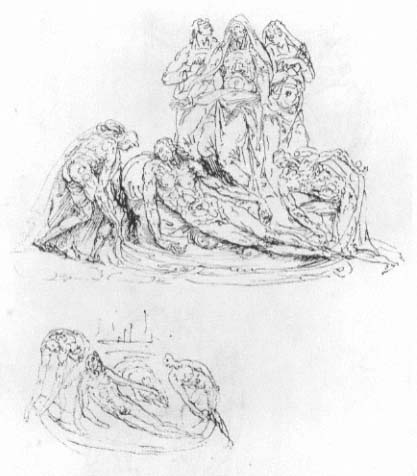
Figure 77.
Guglielmo della Porta, study for a Deposition, c. 1555–59, no. 152,
Kunstmuseum, Düsseldorf, Graphische Sammlung.
of his Passion cycle to such patrons as Cardinal Farnese, Grand Duke Cosimo I de' Medici, and Pope Gregory XIII. Della Porta's preoccupation, even obsession, with the theme of Christ's Passion was so powerful that he intended to carry all his sketches and modelli of the subject to Porlezza, his home, where he wished to spend his last years. Death intervened, and they remained in Rome. One can only speculate whether his obsession had to do with his own spiritual concerns or with the reform interests of the Catholic church. Mostly likely the two were interconnected.
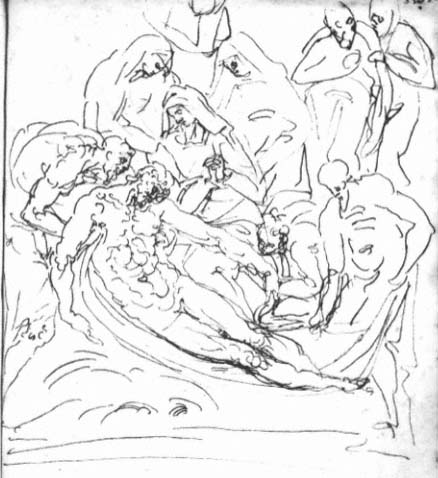
Figure 78.
Guglielmo della Porta, study for a Deposition, c. 1555–59, no. 96,
Kunstmuseum, Düsseldorf, Graphische Sammlung.
Undoubtedly, Giambologna knew della Porta's designs for Passion scenes, and it seems likely that he drew either on his memory of them or even on an example when he composed his own Entombment (Plate 12) for the Grimaldi Chapel. Two drawings from the Düsseldorf sketchbook (nos. 152, 96; Figs. 77, 78), and a marble relief of the della Porta Deposition (Fig. 79) bear similarities to Giambologna's design. One of these similarities is the handling of the central group where Christ's body on the winding sheet is displayed by Nicodemus and Joseph of Arimathea. Both artists placed this central group of three close to the
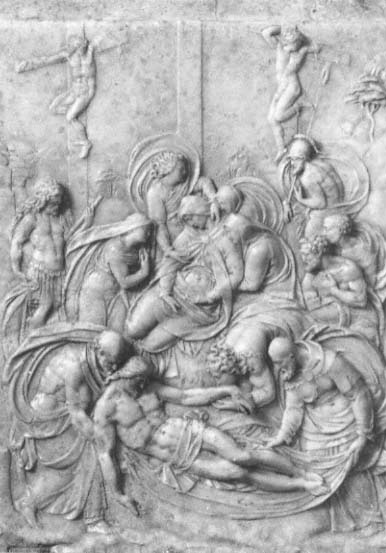
Figure 79.
Guglielmo della Porta, Deposition , marble relief. Museo d'Arte Antica, Milan.
picture plane and turned Christ's body so as to indicate its sacrificial role. This image on the front of the altar embodied for the worshiper the meaning of the mass being celebrated. Both artists used a sweeping curve, locking together the bodies of Nicodemus, Christ, and Joseph of Arimathea as the motif around which their designs are organized. In della Porta's drawings the swirling draperies and open curve of Christ's
body create a rhythmic excitement not present in Giambologna's. Although the draperies on Giambologna's figures hang more believably than those on della Porta's figures, the underlying similarity of the groupings prevails. The powerful physicality of the figures, especially the central three, is notable in both works. Giambologna, however, emphasized the dead weight of Christ's body, particularly his head, his left arm, and his right leg. In contrast, della Porta, even in drawing no. 152 (Fig. 77), where Christ's head falls back, suppressed the naturalistic requirements of the posture in favor of the rhythmic and ornamental. In Giambologna's panel, Nicodemus and Joseph of Arimathea strain harder to handle the heavy body of the dead Savior than their counterparts in della Porta's drawing, who are caught up in the swinging rhythm of the design.
Other differing elements, such as the clarification of space and the simplification of the composition in Giambologna's relief, are easily attributable to generational differences and to the works' different dates. The mood of quiet mourning in the Giambologna relief contrasts with the frenzied quality of the della Porta, with its dense, crowded design filled with billowing draperies and surface patterning. The della Porta belongs to an earlier moment in the history of style when the ideas of simplification and restraint were unacceptable.
Giambologna's redirection in sculpture is similar in principle to changes taking place in painting in the work of Santi di Tito (1536–1603), a competent, if not brilliant, artist seven years younger than Giambologna.[51] Santi's earliest statements in the reform style, Christ at Emmaus (1574) and The Resurrection of Lazarus (Fig. 80), predate the Grimaldi designs by only a few years. In these works Santi's departure from the dominant maniera painting of Rome and Florence constitutes a pioneering effort. The clarity of composition and rationalized light effects of The Resurrection of Lazarus give the spectator a straightforward reading of the event. This work stands in pronounced contrast to a painting like Vasari's Way to Calvary (Fig. 81) in Santa Croce, where exaggerations of posture and flickering light create a complex ornamental effect. Vasari's painting also contrasts strikingly with Giambologna's relief of the same subject (Fig. 5). Whereas Vasari has several centers of interest, Giambologna, like Santi, focuses on the one important confrontation, between Christ and Veronica. Giambologna exploits the emotional power inherent in the meeting between Christ and Veronica; Vasari dilutes it to the point of negation.
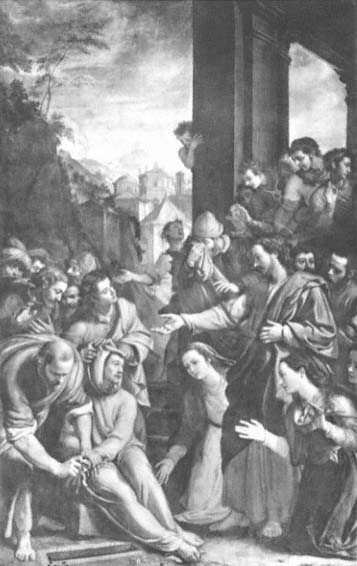
Figure 80.
Santi di Tito, The Resurrection of Lazarus , 1576.
Santa Maria Novella, Florence.
Since Santi di Tito's reform works date from the 1570s, Giambologna's reliefs seem to be among the early works to manifest this change. Other examples in relief sculpture, such as the papal tombs of Sixtus V (1585–90) and Paul V (1605–21) in Santa Maria Maggiore that represent a revival of Lombard narrative style, are later.[52] Their flat-footed narrative tradition, moreover, contains few hints of developments to come
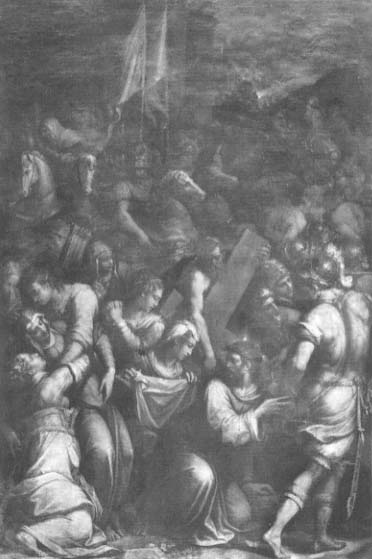
Figure 81.
Giorgio Vasari, The Way to Calvary , 1568.
Santa Croce, Florence.
in the seventeenth century; Giambologna, in contrast, heralded developments that would evolve in the new century. In his Grimaldi cycle, he made a bold statement about the changing relationship between the spectator and the work of art. His strategy addressed one of the main concerns of the Catholic Reformation, that the faithful participate physically and emotionally in the act of worship.